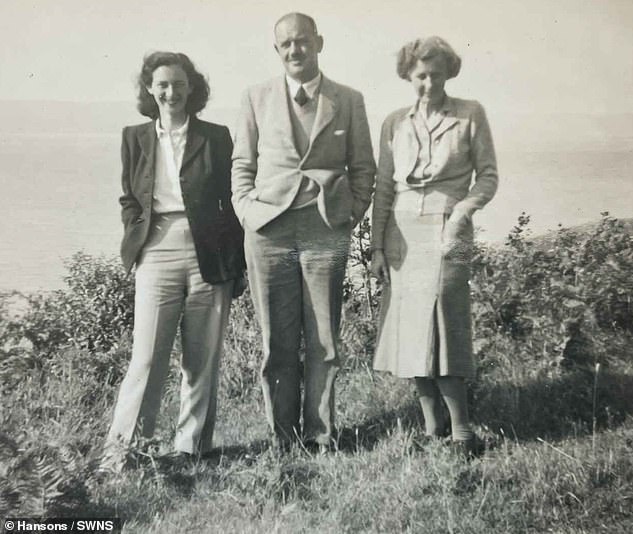- A trunk full of Jean Thomson’s belongings was found during a house eviction
- Glasgow nurse helped treat shell-shocked soldiers at city hospital
- His granddaughter is selling the collection to raise money for veterans charities.
They were a generation of young people traumatized by the horrors of the First World War.
At a time when mental health was little understood, many soldiers in the Great War had to bear the weight of what they had witnessed.
But fascinating insight has been gained into those who were offered help after details of their therapy were found among the belongings of a nurse working at a wartime hospital in Glasgow.
The 1917 album was preserved by Jean Thomson and includes artwork created by shell-shocked soldiers as she encouraged them to draw to aid their rehabilitation.
It will now be auctioned off to benefit a veterans charity after being found in a locked trunk during a home evacuation.
Jean Thomson, right, with her husband Arthur and daughter Nancy on Arran in 1951

The nurse worked at Merryflats Military Hospital in Govan, which later became the site of the Southern General Hospital.
Ms Thomson worked as a nurse at Merryflats War Hospital in Govan, where she was involved in pioneering work to treat what is now known as post-traumatic stress disorder, or PTSD.
She qualified as a doctor in the 1920s and married fellow physician Arthur Browning, whom she met at Glasgow Medical School.
The 107-year-old album also sheds light on the character and sense of humour of the heroes sent to a war that cost the lives of around 40 million people, both military and civilian.
An ironic cartoon shows a seriously wounded soldier telling a nurse, “I feel much better today,” and her response, “And you look much better, too.”
The collection was found by Ms Thomson’s granddaughter, Alison Jean Rutherford, when she was clearing out her mother Nancy’s home following her death in 2022.

Mrs. Thomson encouraged soldiers to draw sketches reflecting their wartime experiences.

A sketch entitled ‘Everybody’s Girl’ made by one of the soldiers being treated by Mrs Thomson
She said: ‘My mother never showed me this album, although she gave me several necklaces of coiled beads and explained how soldiers made them and often gave them to nurses.
‘I found the album in an old trunk full of family papers that I took from her house after she died.
‘Luckily I had the key.
“I felt it was right to share it more widely and I will be donating all the money raised to the Poppy Campaign.”
The wartime album will go under the hammer at Hansons Auctioneers in Etwall, Derbyshire, next week and is expected to fetch between £70 and £100.
Charles Hanson, owner of Hansons Auctioneers, said: ‘Page after page is taken up with sketches and words written by heroes of the trenches.

This sketch of a couple enjoying a walk was also discovered in the album.

A soldier used humor to try to downplay his terrible injuries.
‘Jean encouraged patients to draw and write to aid rehabilitation. He worked with soldiers who had suffered war trauma from the stress of battle.
‘Symptoms included tremors, loss of vision or hearing, and extreme fatigue.
Other World War I memorabilia includes necklaces made for Jean by wounded soldiers using beads and rolled paper.
It may sound strange, but after suffering the horrors of war, creative tasks proved beneficial.
‘In fact, embroidery was used as therapy for wounded soldiers in World War I.
‘The War Office feared this would feminise them, but the skill not only helped with convalescence, but some made a living from embroidery after the war.
“Creativity and its ability to focus the brain are wonderful things. No doubt that’s why a soldier painted a vase of flowers in Jean’s album.”
■ Click here to visit the Scotland homepage for all the latest news and sport.


